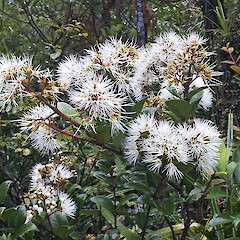Metrosideros albiflora
Common name
white flowering rātā, akatea
Family
Myrtaceae
Flora category
Vascular – Native
Endemic taxon
Yes
Endemic genus
No
Endemic family
No
Structural class
Lianes & Related Trailing Plants - Dicotyledons
NVS code
The National Vegetation Survey (NVS) Databank is a physical archive and electronic databank containing records of over 94,000 vegetation survey plots - including data from over 19,000 permanent plots. NVS maintains a standard set of species code abbreviations that correspond to standard scientific plant names from the Ngä Tipu o Aotearoa - New Zealand Plants database.
METALB
Chromosome number
2n = 22
Current conservation status
The conservation status of all known New Zealand vascular plant taxa at the rank of species and below were reassessed in 2017 using the New Zealand Threat Classification System (NZTCS) – more information about this can be found on the NZTCS website. This report includes a statistical summary and brief notes on changes since 2012 and replaces all previous NZTCS lists for vascular plants.
Please note, threat classifications are often suggested by authors when publications fall between NZTCS assessment periods – an interim threat classification status has not been assessed by the NZTCS panel.
- Conservation status of New Zealand indigenous vascular plants, 2017 . 2018. Peter J. de Lange, Jeremy R. Rolfe, John W. Barkla, Shannel P. Courtney, Paul D. Champion, Leon R. Perrie, Sarah M. Beadel, Kerry A. Ford, Ilse Breitwieser, Ines Schönberger, Rowan Hindmarsh-Walls, Peter B. Heenan and Kate Ladley. Department of Conservation. Source: NZTCS and licensed by DOC for reuse under the Creative Commons Attribution 4.0 International licence.
2017 | Threatened – Nationally Vulnerable | Qualifiers: DP, De
Previous conservation statuses
2012 | Not Threatened
2009 | Not Threatened
2004 | Not Threatened
Brief description
Woody long-climbing vine. Mature plants only reproductive. Adult leaves green, without hairs, elliptic in shape, surfaces without any obvious glandular spotting. Flowers white, fluffy, in dense terminal clusters.
Distribution
Endemic. New Zealand: North Island (confined to the north where it ranges from Te Paki south to Pukemokemoke (north of Hamilton) and the northern Kaimai Ranges)
Habitat
Coastal to montane in forest. Metrosideros albiflora is virtually confined to kauri (Agathis australis) forest associations.
Detailed description
Stout vine up to 20 m. Juvenile and climbing vines sparingly branched, mature (adult) vines much-branched. Bark initially dark brown, maturing grey, ± tessellated, and flaking in tabular shards. Branchlets terete, often curved from base, stiffly erect (sometimes pendent), initially reddish and finely pubescent, soon glabrous. Leaves not markedly dimorphic, evenly spaced (i.e. not close-set), coriaceous, glabrous, petiolate; petioles 2–6 mm long, ± terete, stout; juvenile lamina 10–20 × 10–20 mm, ovate to elliptic-ovate, adaxially green to dark green, paler abaxially, oil glands minute (not evident to naked eye), margins weakly recurved, sparsely hairy, glabrescent; adult lamina 35–90 × 20–46 mm, ovate, elliptic-ovate to elliptic-lanceolate, apex abruptly narrowed, acute or subacute, base cuneate, adaxially green to dark green, abaxially paler, oil glands as for juvenile. Inflorescences in large terminal, compound cymose botyria, each carrying 6–10 white flowers. Hypanthium 8 × 5 mm, broadly urceolate to funnelform, ± fleshy, glabrous, margins exceeding ovary (so forming broad disc); calyx lobes 1.8–2.2 mm long, ovate, obtuse, patent or reflexed at maturity. Petals 5 × 5 mm, caducous, suborbicular to orbicular, margins entire; stamens numerous, 15–30 mm long. Anthers yellow. Style 20–35 mm long, stigma capitate. Capsule 5–10 mm diameter, urceolate, 3–4-valved, woody, dark brown to brown-black when mature. Seeds 1.2–2.4 mm long, narrowly elliptic or narrowly obovate, straight (often curved near apex), light orange-yellow or orange, unfilled seeds darker.
Manaaki Whenua Online Interactive Key
Similar taxa
Metrosideros albiflora, despite the unfortunate vernacular “white rata” is not very similar to the other “white rata” M. perforata, which has much smaller, glandular punctate leaves, and smaller more numerous clusters of white flowers. The glabrous stems, tinged red when young, large, glabrous, elliptic-ovate to elliptic-lanceolate (rarely ovate), acute to subacute, green adult leaves, much larger, white flowers, and late winter to spring flowering habit serve to distinguish it from all other similar Metrosideros vines.
Flowering
August–November
Flower colours
White
Fruiting
January–April
Propagation technique
Although a beautiful species, M. albiflora is not commonly cultivated and it has a reputation for being difficult. Like all other climbing rata it can be grown from rooted pieces and from semi-hardwood cuttings. However like all Metrosideros cuttings can be fickle to strike. This species is cold sensitive.
Threats
Metrosideros albiflora is often absent from large parts of potential range. It is most common in central and western Northland and the Coromandel Peninsula. Adult vines are often browsed by possums.
When myrtle rust (Austropuccinia psidii) was detected in New Zealand (May 2017) the conservation status was upgraded as a precautionary measure to ‘Threatened – Nationally Vulnerable’ because, on best advice, it was believed that no indigenous Myrtaceae had resistance to the myrtle rust disease (de Lange et al. 2018).
Myrtle rust (Austropuccinia psidii) is an invasive fungus that threatens native myrtle species. Learn more myrtlerust.org.nz.
Etymology
metrosideros: Iron heart
albiflora: From Latin albus ‘white’ and florus ‘flower’
Where To Buy
Occasionally sold by specialist native plant nurseries
Attribution
Fact sheet prepared for NZPCN by P.J. de Lange (6 January 2013). Description from herbarium specimens and fresh material
NZPCN Fact Sheet citation
Please cite as: de Lange, P.J. (Year at time of access): Metrosideros albiflora Fact Sheet (content continuously updated). New Zealand Plant Conservation Network. https://www.nzpcn.org.nz/flora/species/metrosideros-albiflora/ (Date website was queried)





